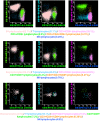Flow cytometric characterization of cecal appendix lymphocyte subpopulations in children: a pilot study
- PMID: 37736768
- PMCID: PMC10516785
- DOI: 10.1007/s00383-023-05558-z
Flow cytometric characterization of cecal appendix lymphocyte subpopulations in children: a pilot study
Erratum in
-
Correction to: Flow cytometric characterization of cecal appendix lymphocyte subpopulations in children: a pilot study.Pediatr Surg Int. 2023 Nov 7;39(1):289. doi: 10.1007/s00383-023-05567-y. Pediatr Surg Int. 2023. PMID: 37934293 Free PMC article. No abstract available.
Abstract
Introduction: Scientific literature regarding the characterization of lymphocyte subpopulations of the cecal appendix is sparse, with few precedents limited to immunohistochemical techniques.
Methods: We conducted a prospective pilot study to characterize lymphocyte subpopulations of the cecal appendix in children. Participants were divided into three groups: (1) patients without histological acute appendiceal inflammation, (2) patients with histological uncomplicated acute appendicitis, and (3) patients with histological complicated acute appendicitis (gangrenous, perforated). A fresh sample of the base of the appendix was taken from all patients and a flow cytometric study was performed. Quantitative variables were compared using Kruskal-Wallis test and Mann-Whitney U test.
Results: This study included 57 patients divided into Group 1 (n = 5), Group 2 (n = 37), and Group 3 (n = 15). Median values (IQR) of the percentage of B-lymphocytes were 67.8 [66.8-68.1] in group 1, 61.15 [53.74-66.4] in group 2, and 52.1 [33-62.02] in group 3 (p = 0.02). Median values (IQR) of the percentage of NK-lymphocytes were 0.26 [0.2-0.3] in group 1, 0.55 [0.37-0.66] in group 2, and 0.84 [0.35-1.45] in group 3 (p = 0.008). Median values (IQR) of the percentage of T-lymphocytes were 31.9 [31.7-33.1] in group 1, 37.68 [32.15-45.69] in group 2, and 46.9 [37.03-67] in group 3 (p = 0.02). Pair comparisons of groups 2 and 3 also showed significant differences in the percentage of B lymphocytes (p = 0.03) and NK-lymphocytes (p = 0.02).
Conclusions: Significant differences in lymphocyte subpopulations were identified according to the histologic grade of the cecal appendix. More specifically, a lower percentage of B-lymphocytes and a higher percentage of T- and NK-lymphocytes were observed in cases of acute appendicitis. These findings must be confirmed and their etiopathogenic, diagnostic, and prognostic implications elucidated in future studies with larger sample sizes.
Keywords: B-lymphocytes; Flow cytometry; NK-lymphocytes; Pediatric acute appendicitis; T-lymphocytes.
© 2023. The Author(s).
Conflict of interest statement
The authors declare that they have no conflict of interest.
Figures




Similar articles
-
Is CD19 an immunological diagnostic marker for acute appendicitis?Iran J Immunol. 2013 Dec;10(4):216-28. Iran J Immunol. 2013. PMID: 24375063
-
Immunocytochemical analysis of cellular infiltrates in human appendicitis.Surg Today. 2000;30(12):1083-8. doi: 10.1007/s005950070005. Surg Today. 2000. PMID: 11193739
-
New CT criterion for acute appendicitis: maximum depth of intraluminal appendiceal fluid.AJR Am J Roentgenol. 2007 May;188(5):1313-9. doi: 10.2214/AJR.06.1180. AJR Am J Roentgenol. 2007. PMID: 17449776
-
Beyond appendicitis; radiologic review of unusual and rare pathology of the appendix.Abdom Radiol (NY). 2016 Mar;41(3):568-81. doi: 10.1007/s00261-015-0600-z. Abdom Radiol (NY). 2016. PMID: 27039327 Review.
-
Torsion of cecal appendix. Report of the first Italian case and review of the literature.Pediatr Med Chir. 2021 May 7;43(1). doi: 10.4081/pmc.2021.251. Pediatr Med Chir. 2021. PMID: 33960760 Review.
Cited by
-
Acute Appendicitis in the Elderly: A Nationwide Retrospective Analysis.J Clin Med. 2024 Apr 8;13(7):2139. doi: 10.3390/jcm13072139. J Clin Med. 2024. PMID: 38610904 Free PMC article.
References
-
- Gadiparthi R, Waseem M. StatPearls [Internet] Treasure Island: StatPearls Publishing; 2023. Pediatric appendicitis. - PubMed

